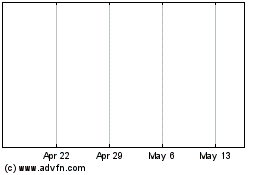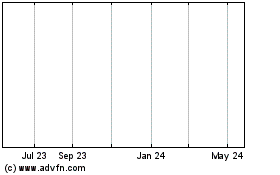Floating-Rate Notes Resurface On Changing Interest-Rate Outlook
February 01 2011 - 12:17PM
Dow Jones News
Corporate borrowers are switching up the composition of their
debt sales, throwing more floating-rate notes into the mix to
entice investors who believe interest rates may be about to rise
sooner and faster than expected.
Nearly $26 billion, or 23%, of the U.S.-marketed
investment-grade bonds so far this year have floating rates,
according to data provider Dealogic, making it the busiest January
for so-called floaters since 2007. That compares with $57.4
billion, or 7% of the supply, for all of 2010.
Bankers expect floating-rate issuance to continue this year for
two reasons: Investors want to position their portfolios for a
potential rise in rates; and issuers are suddenly more comfortable
selling them.
"Rising expectation of future policy rate increases is boosting
demand for floaters as investors look to manage their interest-rate
duration," Eric Beinstein, head of U.S. high-grade credit strategy
and credit derivatives research at J.P. Morgan, wrote in a market
commentary Tuesday.
Financial institutions tend to be the biggest issuers of
floating-rate debt, to bring their funding in line with assets such
as floating-rate loans. Financial firms, including insurers as well
as banks, account for 63% of the U.S. high-grade issuance in dollar
volume so far this year, the highest percentage for any January
since at least 1995, when Dealogic started keeping records. Most of
that--57% of the total--was from banks.
Heavy issuance by foreign banks is exaggerating the trend. They
borrow in the U.S. because investor appetite is stronger here than
in their domestic markets. January saw the largest volume of these
so-called Yankee deals--dollar-denominated bonds sold by foreign
firms in the U.S.--than any other month on record, at $64.1
billion.
"Since the euro markets were less friendly to new issuance,
floater deals that would normally have come as euro bonds were
instead dollar issues," said Guy LeBas, chief fixed income
strategist at Janney Capital Markets in Philadelphia.
Groupe BPCE, France's second-largest banking group, sold $1.1
billion of three-year, floating-rate notes on Monday for a yield of
1.80 percentage points over the three-month London interbank
offered rate, a measure of what banks charge to lend to each
other.
Last Thursday, ABN AMRO Bank NV, which bears similar credit
ratings to BPCE, sold $2 billion of fixed- and floating-rate bonds,
with the floaters pricing at a yield of 1.77 percentage points over
that London benchmark rate, known as Libor.
Not all the floaters have come from banks, however. A week ago,
global brewer Anheuser-Busch InBev sold $1.65 billion of bonds,
split between fixed and floating. The batch of three-year floaters
was added after the deal was announced, taking the deal over its
initial $1 billion size.
"Investors are using these floaters to shorten duration and
express their view on the pace of future Fed tightening," said
Michael Hyman, head of investment-grade credit at ING Investment
Management, which bought $20 million of the ABN AMRO floaters.
Most of the floating-rate debt sold this year has been clustered
around two- and three-year maturities, as was the case in 2009.
Last year's issuance was more evenly spread between three-, five-
and 10-year floaters.
There is about $32 billion of floating-rate, Federal Deposit
Insurance Corporation-insured bonds under the government's
Temporary Liquidity Guarantee Program maturing this year, said
LeBas, all of which needs to be refinanced--including $5 billion in
the first quarter.
"Given that all the government-guaranteed debt from 2009 is
maturing in 2011, banks will be able to issue short-term floaters
beyond that maturity cliff," said Justin D'Ercole, head of Americas
investment-grade syndicate at Barclays Capital. "As opposed to the
last two years, when it would have had the effect of adding to
their massive wall of maturities, it now fits into their
debt-distribution profile."
-By Katy Burne, Dow Jones Newswires; 212-416-3084;
katy.burne@dowjones.com
Abn Amro (NYSE:ABN)
Historical Stock Chart
From Jun 2024 to Jul 2024

Abn Amro (NYSE:ABN)
Historical Stock Chart
From Jul 2023 to Jul 2024
